‘Art as We Don’t Know It’: Against the Unbearable Whiteness of Bioart
Published 27 May 2020 by Rob La Frenais
The recently published ‘Art as We Don’t Know It’ catalogue showcases art and research that has grown and flourished within the wider network of both the Bioart Society and Aalto University’s Biofilia lab in Finland during the previous decade. The book features a selection of texts, personal accounts and interviews, artistic contributions and collaborative projects which illustrate the breadth and diversity of bioart. Review.
There’s a good case for arguing that the compendious “Art As We Don’t Know It” should be read backwards, starting with the glossary. There’s a welter of recent concepts that have been given names here, from ‘Xenophilic’ to ‘De-Extinction’, from ‘Gynepunk’ to ‘New-to-Nature Lifeform’, from ‘Wetlab’ to ‘Biophilosophy’. Ah ‘Bio’! Is it ‘Bio-art’ or ‘Bioart’, or as SymbioticA’s Oron Catts has argued in the past, ‘Biological Art’? Is Bioart a genre or a variation, like Land Art, Arte Povera, Space art, Machine Art, Outsider Art and finally, the worst example of all, invented by the UK’s Wellcome Trust in the 90s ‘Sci-Art’? There are also those who have eagerly jumped on this bandwagon such as academic Prof. Arthur Miller, who in his book ‘Colliding Worlds’ on art and science, claims there is such a horrible hybrid as ‘Artsci’. As someone who has worked extensively with scientists and artists, I maintain it is a big mistake to hybridise these two job descriptions, which can and do nevertheless engage in creative conversation and collaboration.
‘Art As We Don’t Know It’ is, then, a quite clever catch-all title for art operating in areas yet to be defined or named. The Bioart Society, publisher of this book, along with Aalto University, is stuck with the name, however and director Erich Berger is no stranger to wordplay, having organised a contest on social media for people to come up with versions of ‘Anthropocene’. He named them ’Anthropomemes’ , following Donna Haraway’s ‘Chthulucene’. This generated some creative examples ‘Manthropocene’ (Kate Raworth), Schnubeleduldidlo-cene (Marc Dusseiller Dusjagr) and Oops-a-day-cene (Tiina Prittinen). Some of these are listed in Berger’s chapter: ‘Radical Witnessing’. I seem to remember proposing ‘Notquitemyscene’ myself. To return to the topic, ‘Art As We Don’t Know It’ is not just about bioart but documents a quite breathtaking series of projects that took place both at the Bioart society but also in the Kilpisjärvi station in the Arctic and the Aalto-University based Biofilia lab (Base for Biological Arts). It’s a large collection of material and I will have to limit myself to a few examples of writing here.
Firstly the date this has been published, early 2020, means this book would have been much different if it had been published a little later, now the whole planet has really has become a laboratory. It may well be that it will be much more difficult to conduct artistic experiments in areas like xenobiology now that the cross-species viral genie is out of the bottle (whether issuing from exotic wet market or lab – still under discussion as I understand). From the glossary: ‘xenomogrification’-‘transformation into the alien and the other for the purposes of desalienation’ may be a useful field of study.
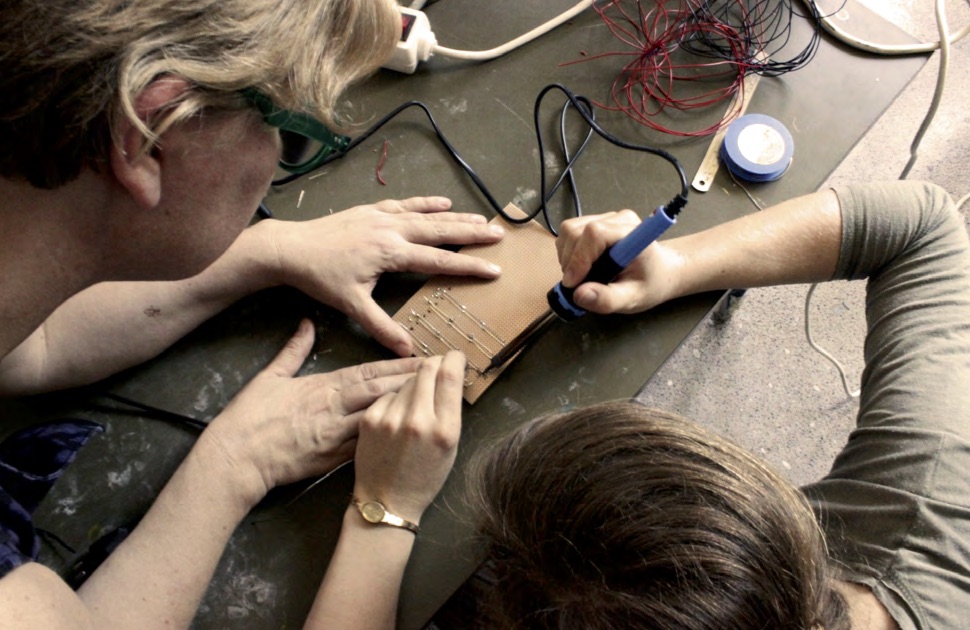
In her introduction, Monica Bello, Arts Director at CERN also goes into the definition game, say that artists are by nature ‘experimenters…collectors and natural relators’, while in their introduction, the editors introduce an alternative title ‘Life As We Don’t Know It’ referring to ‘Synthetic Biology’, now shortened to ‘Synbio’. In what might be called a ‘keynote’ article, scientists Markus Schmidt & Nediljko Budisa open this area, describing in learned terms the behaviour of what they call ‘new-to-nature’ life forms, displaying an alternative to xenophobia – xenophilia – love of the strange’ and rather radically proposing the techno-optimistic possibility that synthetic biology could used to reverse the current mass species extinction, using the term ‘de-extinction’.
Later in the book, Oron Catts and Ionat Zurr of SymbioticA rail against the view of art within this new field “Some may say that the inclusion of artists, within the field of synthetic biology for example, served as, if not an explicit promotion of the field, at least as a force of superficial “debate” around the social and biopolitical issues raised through the new technologies that will eventually lead to the domestication of the technology. The artist was traditionally allowed to act as a provocateur or contester, or put it bluntly, in this context, the role of the artist might be like that of a medieval court jester.” They ask: “What kind of provocation can an artist make that cannot be utilised or capitalised by other, opposing, propagandist agendas, can make an active and lasting change in society, can make sense of the new-found relationship with matter (in this case life)?”
The Bio and the Xeno
To give an example of an artist that simply cannot be labelled as ‘bioart’ is the Belgian artist Bartaku – who describes his “main interests lie in cognitive ecology, consciousness studies, neurobiology, energy and the philosophy of knowing and becoming. His practice is often process- based, collaborative and situated in the folds and cracks of formal classifications. Most renowned is the questioning of mankind’s relation with energy in temporary Photoelectric Digestopians, featuring edible solar cells and human tongues “. You really can’t wrap that up in one hybrid generic term.
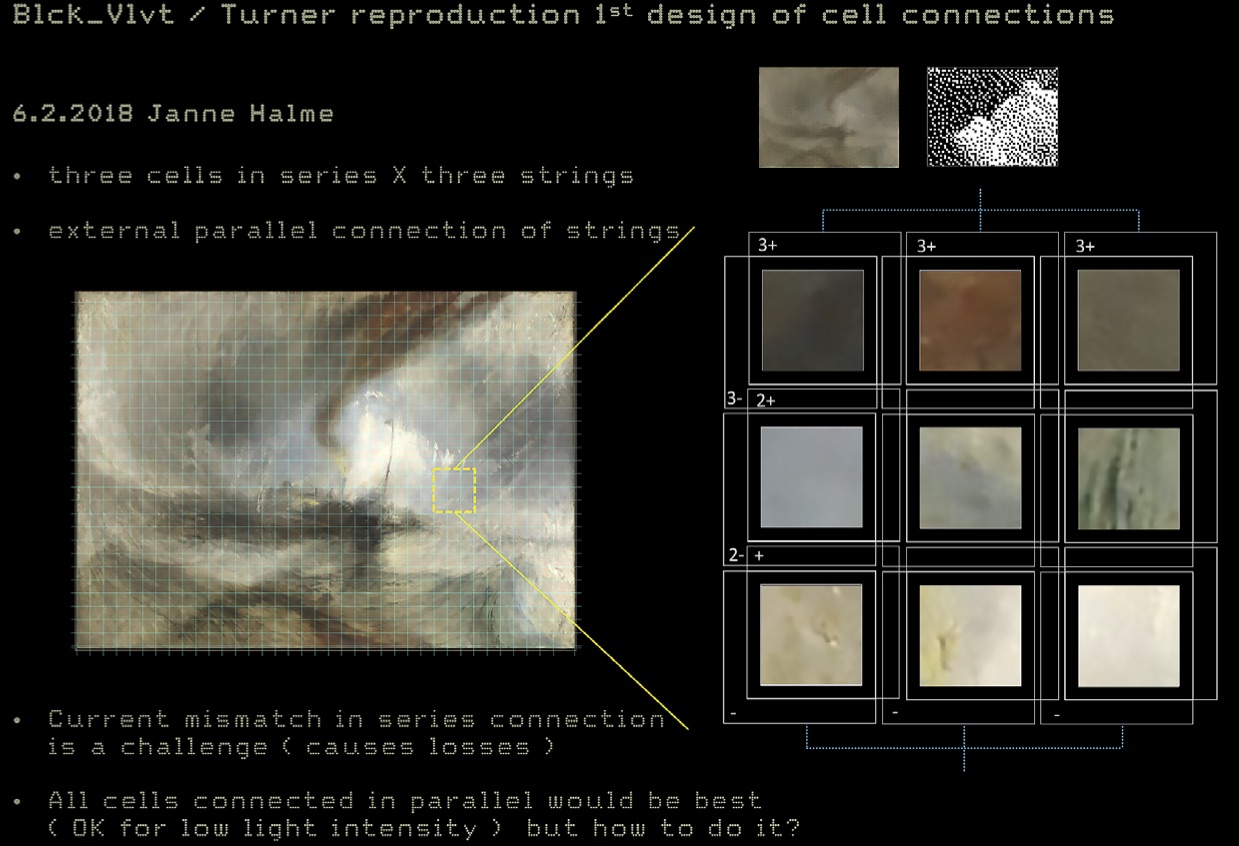
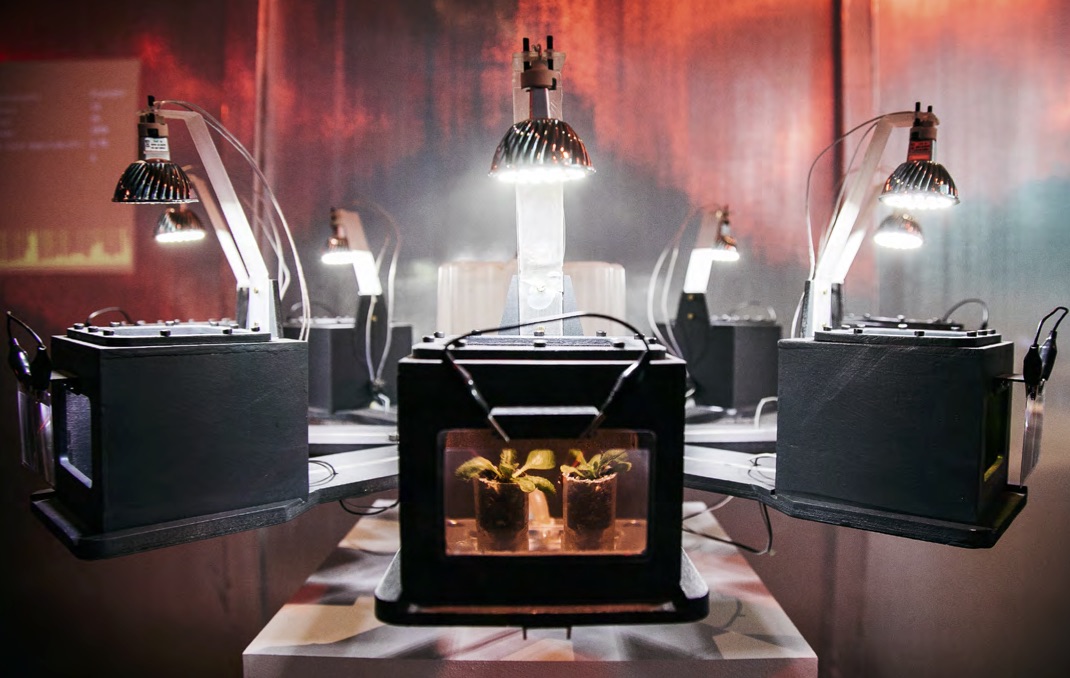
Andy Gracie undertakes what he calls ‘terrestrial astrobiology’ where he tries to simulate extreme environments on Earth and tests living organisms in, say the atmosphere of a gas giant. He’s moved on from the project I curated back in 2013 for The Arts Catalyst ‘Republic of the Moon’ at FACT, Liverpool ‘Drosophilia Titanus’ where he tried to keep fruit flies alive with vodka and a pressure pump to approximate conditions on the Saturn moon Titan, to a project with extremophiles in what he calls the Deep Data project. He proposes that “we must keep looking outwards to find the boundary of life by exploiting the outermost information we have. It also proposes cultural and critical examination of our quest to find other forms, habitats, and strategies for life by reviewing technological processes while asking philosophical questions about their discovery.”
Adriana Knouf describes ‘self-experimenting’ using HRT technologies to biohack her own transgender body. A practitioner of ‘xenology’ or ‘xenofeminism,’ she questions the lack of reproductive research among female astronauts and she herself launched her own HRT cell experiment to the International Space Station on the Cubesat TX-1 on March 6 of this year, returning to Earth on April 1 (read her interview in Makery).
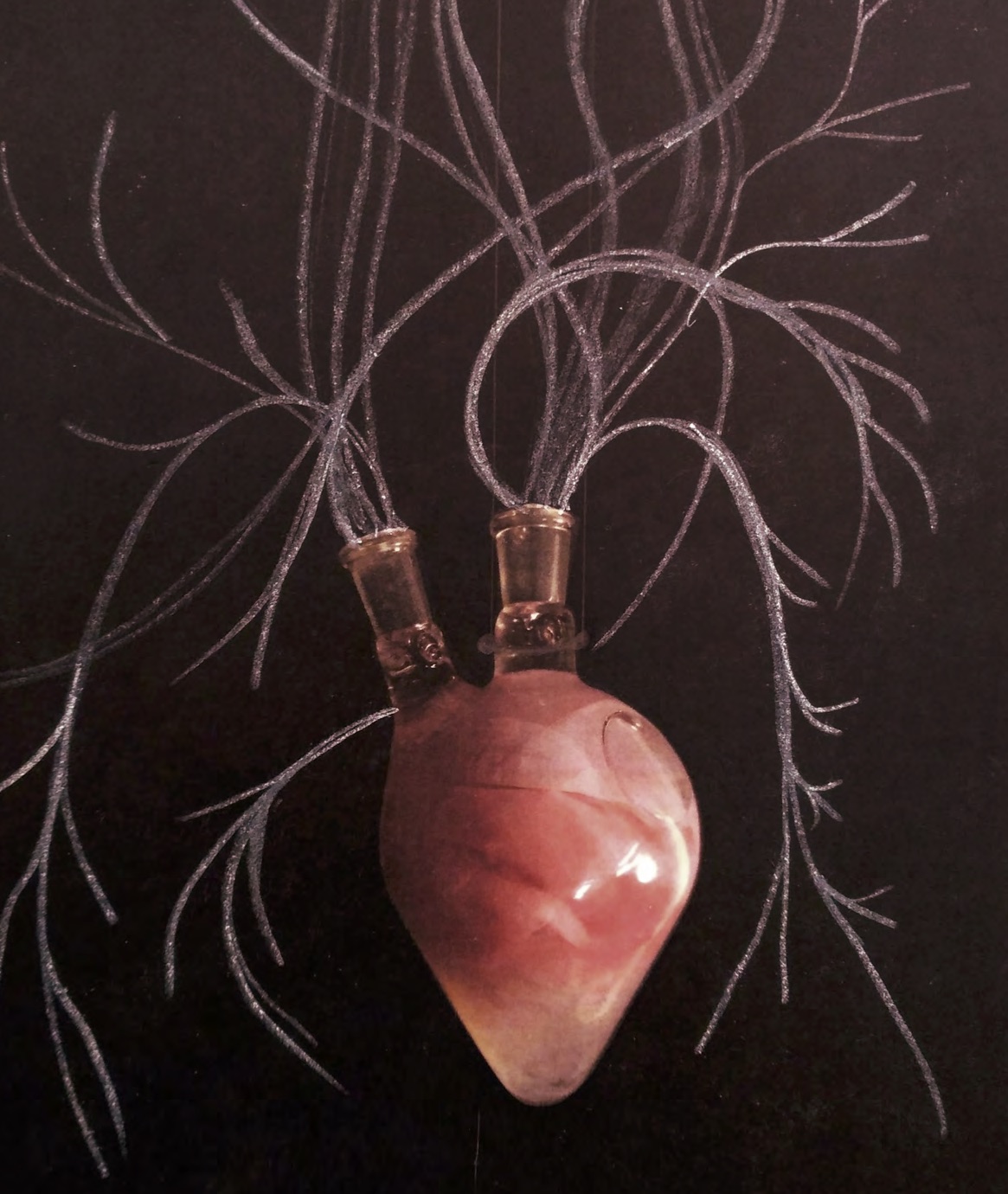
Another biohacker artist represented here is Margherita Pevere who asks “what effect might gastropod sexualities and hormones have on humans?” Her work ‘Wombs’ “develops and subverts the human-gastropod relationship at the bridge of mucus and sexuality in a non/living sculpture with the artist’s vaginal epithelial cells, slug stem cells, the artist’s urine extract, slug mucus.” I met her at Biofilia two years ago as she was trying to work out how to do this complex work, knowing as we do, that the water supply is contaminated with oestrogen from oral contraception entering the water environment. Other examples of artists who refuse to be categorised as simply bioartists are the duo Špela Petrič and Miha Turšič, whose ‘Voyager’/non-human agents’ project proposes to send an artificial life algorithm to the rapidly receding ‘Voyager 2 probe. They like to think of these probes as artificial life-forms themselves – no need to send Sagan’s ‘golden record’.
There are several examples here of artists of projects and artworks I had not heard of before. Erich Berger, in his essay ‘Radical Witnessing’, cites ‘time vehicles’ such as that of Gerrit Van Bakel, whose Utah/Tarim Machine’ was set to travel at 18 millimetres a day across across the 1000 km wide Tarim Desert. He calculated it would take 30 million years but if you check the maths it was a bit out, it would take 17,000 years. Laura Beloff in her essay “Hybrid Ecologies- To See the Forest For the Trees’ cites the work of Cargo Collective’s Helga Steppan’s I can Hear you, can you see me? (The Baumbeobachter) where she photographs mobile phone masts disguised as trees.
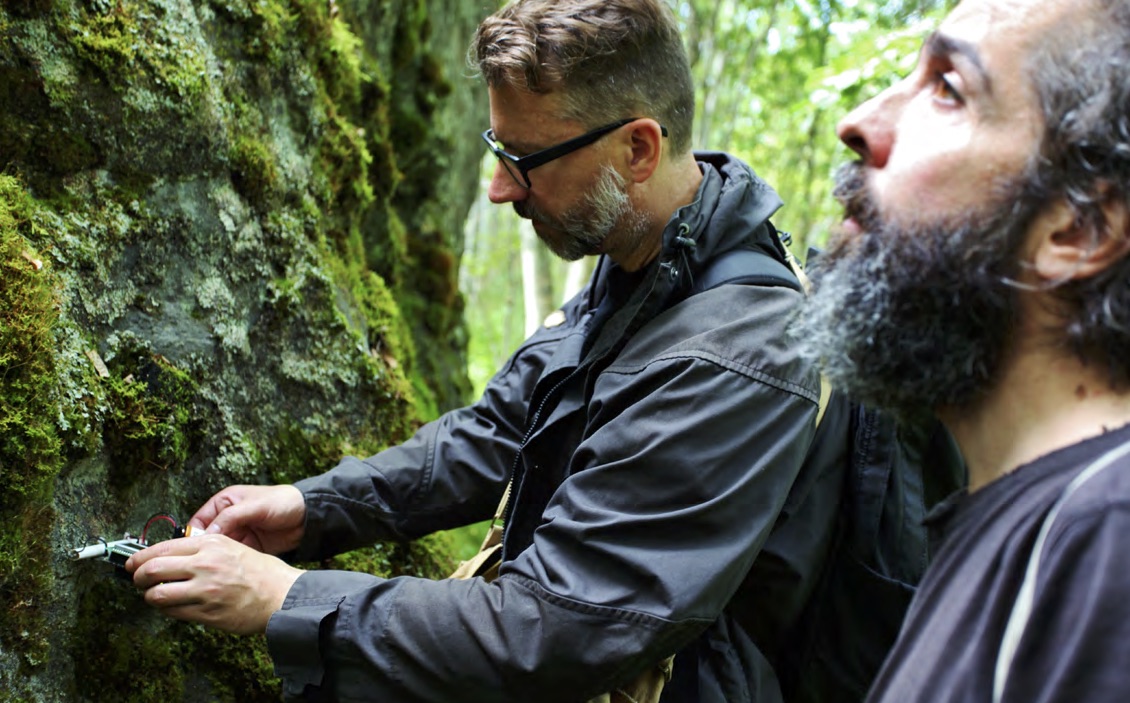
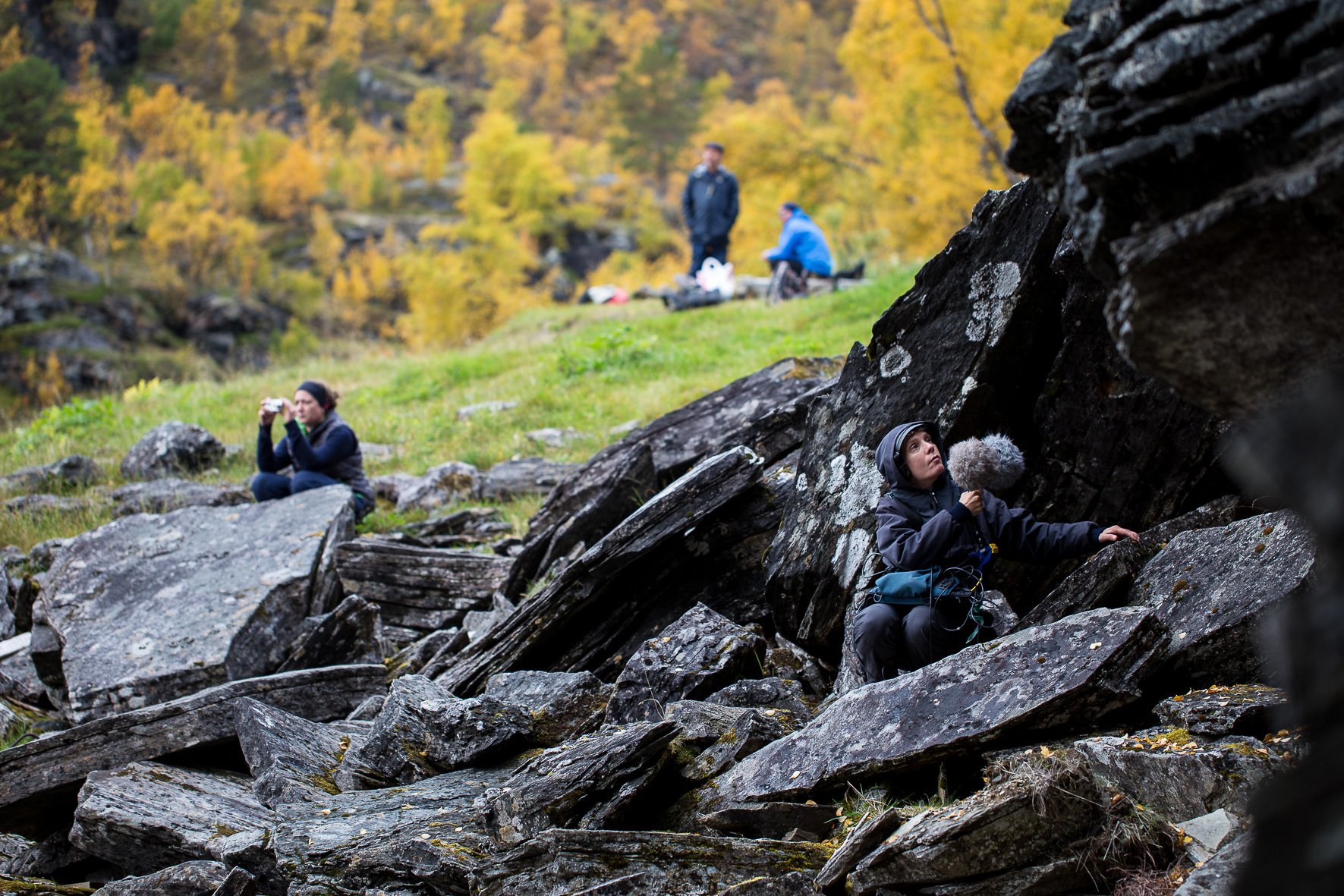
Ars Bioarctica and the Field Notes expeditions to the Kilpisjärvi Field station (read the reports on Field Notes in Makery) also contain a multiplicity of radical art experiments. One example is ‘Machine Wilderness’ with various robotic equivalents of wildlife being tested, such as Antti Tenetz’s ‘Hawk Vision’ where drones with ultra violet sensors detect vole urine (something hawks have apparently forgotten to do) and asks if machine need training forests, or if AI’s need to learn how to fish like the Sami in a fast-flowing river.
Rituals
Finally, in an interesting section on ritual, Kira O’Reilly’s performance experiment ‘What If This Is the Only World we know’ how the artist “collaborates with humans of various types and technologies and non-humans of numerous divergences including mosses, spiders, the sun, pigs, cell cultures, horses, micro-organisms, bicycles, rivers, landscapes, tundras, rocks, trees, shoes, food, books, air, moon and ravens”. Again, not entirely definable as bioart.
When I read the title of the essay ‘Illuminating Multiplicity – Against the Unbearable Whiteness of Bioart’ by Heather Davis, Elaine Gan & Terike Haapoja I immediately thought it was a cri-du-coeur against the whiteness and cleanness of the wetlab and the compulsory wearing of white coats (ever-contrary, Oron Catts insists on wearing a black labcoat). However, this was a useful challenge to the ‘transhuman’ and posthuman’ positions taken by many here, the lab not only being a white space but one dominated by white people. They write “The human, despite its apparent neutrality, should never be taken for granted as a neutral or inclusive position. This results in the ways that whiteness continues to claim a privileged access to the ‘natural’ because of its supposed neutrality, its production as the standard of the biological and ideological human. The so-called ‘posthuman’ turn in theory and art practice that, while necessarily calling attention to the violent division of human and non-human worlds, also serves to occlude the ways in which this division is used to justify the violence against nonwhite bodies”. Diverse artists here include Tamara Pertamina with her Crispr Sperm Bank, and Mother The Verb with Ivy Monteiro and Javier Stell-Frésquez, Paul Vanouse with his Labor project (read Paul Vanouse’s interview about his project in Makery – editor’s note) and others.
Perhaps the last word can go to Shruti Sunderraman, who took part in one of the recent Field Notes. In her endnote ’There is no Lost and Found department at the Kilpisjärvi Biological Station’. “I went looking for a lost thermos. I heard someone yell, “I can’t find my other sock!” We all found ourselves searching for belongings in a place that doesn’t have a Lost and Found department. …Befriend reindeers. Respect their need for distance. Be gentle to their caution. The mountain and the reindeer have outlived human conclusions. They do not have your lost charger. They have sensibilities to offer. Drop your apparatus. Let them test you now. If you have lost your compass at the Kilpisjärvi Biological Station, give up all will to find it. Some things ought to stay lost.”
As a curator I have followed the artistic and philosophical paths of many of the artists documented in ‘Art As We Don’t Know It’. It’s good to have them all in one place in this useful and dense volume.
‘Art As We Don’t Know It’ was edited by Erich Berger, Kasperi Mäki-Reinikka, Kira O’Reilly and Helena Sederholm.
